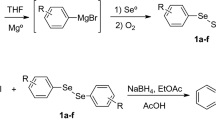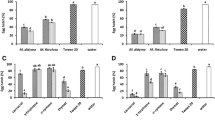Abstract
Recent research has been focused on the potential of plant natural products for the control of nematodes, but few studies are reported on synergistic interactions and egg hatch inhibition properties of botanicals. Herein, we evaluate the nematicidal activity of (E,E)-2,4-decadienal, 2-undecanone, furfural and (E)-2-decenal alone and in binary mixtures, on different Meloidogyne spp. and growth stages. (E,E)-2,4-decadienal exhibited strong paralysis activity on second-stage M. incognita, M. javanica and M. arenaria juveniles (EC50/4d = 8.06, 9.04 and 12.90 μg mL−1, respectively) and all its binary mixtures demonstrated synergy on all nematode species. (E,E)-2,4-decadienal best inhibited M. incognita undifferentiated egg hatch and J2 release from eggs immersed in 10 μg mL−1 solution. SEM experiments revealed malformations, in the form of constrictions, along the larvae body retained in eggs treated with (E)-2-decenal. Egg masses treated with 1 μg mL−1 solution of (E)-2-decenal released less than 50 % of the eggs if compared with the control. (E)-2-decenal and (E,E)-2,4-decadienal arrested M. incognita life cycle in pot bioassays (EC50 = 77.46 and 114.47 mg kg−1), with the latter additionally promoting tomato growth. Ailanthus altissima powder (AWP) and water extract (AWE), naturally containing (E,E)-2,4-decadienal and (E)-2-decenal, strongly arrested M. incognita life cycle in tomato plants, and AWP was far more active than AWE. Thus, we conclude that (E,E)-2,4-decadienal and (E)-2-decenal are promising nematicidal agents used alone, in artificial blends or as naturally present in botanical soil amendments.




Similar content being viewed by others
References
Ahmed N, Abbasi MW, Shaukat SS, Zaki MJ (2009) Induced systemic resistance in mung bean plant against root-knot nematode Meloidogyne javanica by dl-β-amino butyric acid. Nematol Mediterr 37:67–72
Amdadul Hoque AKM, Rejwan Bhuiyan M, Ashik Iqbal Khan M, Mahmud A, Uddin Ahmad M (2014) Effect of amino acids on root-knot nematode (Meloidogyne javanica) infecting tomato plant. Arch Phytopathol Plant Prot 47:1921–1928
Atolani O, Fabiyi OA, Olatunji GA (2014) Isovitexin from Kigelia pinnata, a potential eco-friendly nematicidal agent. Trop Agric 91:67–74
Barbary A, Djian-Caporalino C, Palloix A, Castagnone-Sereno P (2015) Host genetic resistance to root-knot nematodes, Meloidogyne spp., in Solanaceae: from genes to the field. Pest Manag Sci 12:1591–1598
Bellafiore S, Shen Z, Rosso MN, Abad P, Shih P, Briggs SP (2008) Direct identification of the Meloidogyne incognita secretome reveals proteins with host cell reprogramming potential. PLoS Pathog 4:e1000192
Berenbaum MC (1989) What is synergy. Pharmacol Rev 41:93–141
Byrd DW, Krikpatrick T, Barker KR (1983) An improved technique for cleaning and staining plant tissue for detection of nematodes. J Nematol 15:142–143
Caboni P, Ntalli NG, Aissani N, Cavoski I, Angioni A (2012) Nematicidal activity of (E,E)-2,4-decadienal and (E)-2-decenal from Ailanthus altissima against Meloidogyne javanica. J Agric Food Chem 60:1146–1151
Caboni P, Aissani N, Cabras T, Falqui A, Marotta R, Liori B, Ntalli N, Sarais G, Sasanelli N, Tocco G (2013) Potent nematicidal activity of phthalaldehyde, salicylaldehyde, and cinnamic aldehyde against Meloidogyne incognita. J Agric Food Chem 61:1794–1803
Caboni P, Tronci L, Liori B, Tocco G, Sasanelli N, Diana A (2014) Tulipaline A: structure-activity aspects as a nematicide and V-ATPase inhibitor. Pestic Biochem Physiol 112:33–39
Curtis RH (2008) Plant-nematode interactions: environmental signals detected by the nematode’s chemosensory organs control changes in the surface cuticle and behaviour. Parasite 15:310–316
Douda O, Zouhar M, Mazáková J, Nováková E, Pavela R (2010) Using plant essences as alternative mean for northern root-knot nematode (Meloidogyne hapla) management. J Pest Sci 83:217–221
Fatemy S, Moslemi F, Bernard F (2014) Seed treatment and soil drench with dl-β-amino butyric acid for the suppression of Meloidogyne javanica on tomato. Acta Physiol Plant 36:2311–2317
Hu Y, Zhang W, Zhang P, Ruan W, Zhu X (2013) Nematicidal activity of chaetoglobosin a poduced by Chaetomium globosum NK102 against Meloidogyne incognita. J Agric Food Chem 61:41–46
Hussey RS, Barker KR (1973) A comparison of methods of collecting inocula of Meloidogyne spp., including a new technique. Plant Dis Rep 57:1025–1028
Jung WJ, Kim KY, Park YS, Kim SB, Lee YS, Anees M (2014) Purification and properties of a Meloidogyne-antagonistic chitinase from Lysobacter capsici YS1215. Nematol 16:63–72
Lee JJ, Kong M, Ayers GD, Lotan R (2007) Determination interaction in combination therapy. J Biopharm Stat 17:461–480
Lee YS, Anees M, Hyun HN, Kim KY (2013) Biocontrol potential of Lysobacter antibioticus HS124 against the root-knot nematode, Meloidogyne incognita, causing disease in tomato. Nematol 15:545–555
Masler EP, Rogers ST, Chitwood DJ (2013) Effects of catechins and low temperature on embryonic development and hatching in Heterodera glycines and Meloidogyne incognita. Nematol 15:653–663
Naz I, Palomares-Rius JE, Saifullah Blok V, Khan MR, Ali S, Ali S (2013) In vitro and in planta nematicidal activity of fumaria parviflora (fumariaceae) against the southern root-knot nematode Meloidogyne incognita. Plant Pathol 62:943–952
Nguyen DM, Seo DJ, Kim KY, Park RD, Kim DH, Han YS, Kim TH, Jung WJ (2013) Nematicidal activity of 3,4-dihydroxybenzoic acid purified from Terminalia nigrovenulosa bark against Meloidogyne incognita. Microb Pathog 60:52–59
Ntalli NG, Caboni P (2012a) Botanical nematicides: a review. J Agric Food Chem 60:9929–9940
Ntalli NG, Caboni P (2012b) Botanical nematicides in the mediterranean basin. Phytochem Rev 11:351–359
Ntalli NG, Vargiu S, Menkissoglu-Spiroudi U, Caboni P (2010) Nematicidal carboxylic acids and aldehydes from Melia azedarach fruits. J Agric Food Chem 58:11390–11394
Ntalli NG, Manconi F, Leonti M, Maxia A, Caboni P (2011a) Aliphatic ketones from Ruta chalepensis (Rutaceae) induce paralysis on root knot nematodes. J Agric Food Chem 59:7098–7103
Ntalli NG, Ferrari F, Giannakou I, Menkissoglu-Spiroudi U (2011b) Synergistic and antagonistic interactions of terpenes against Meloidogyne incognita and the nematicidal activity of essential oils from seven plants indigenous to Greece. Pest Manag Sci 67:341–351
Ntalli NG, Nasiou E, Menkissoglu-Spiroudi U (2013) Evaluation of essential oils from rosemary, orange, lavandula and false yellowhead on hatching and motility of Root-Knot Nematode. J Agric Sci Tech A 3:603–616
Puntener W (1981) Manual for field trials in plant protection, 2nd edn. Ciba-Geigy Limited, Basle
Seefeldt SS, Jensen JE, Fuerst EP (1995) Log-logistic analysis of herbicide dose response relationships. Weed Technol 9:218–227
Sousa RMOF, Rosa JS, Silva CA, Almeida MTM, Novo MT, Cunha AC, Fernandes-Ferreira M (2015) Larvicidal, molluscicidal and nematicidal activities of essential oils and compounds from Foeniculum vulgare. J Pest Sci 88:413–426
Wen Y, Meyer SLF, Masler EP, Zhang F, Liao J, Wei X, Chitwood DJ (2013) Nematotoxicity of drupacine and a Cephalotaxus alkaloid preparation against the plant-parasitic nematodes Meloidogyne incognita and Bursaphelenchus xylophilus. Pest Manag Sci 69:1026–1033
Yamashita TT, Viglierchio DR (1987) In vitro testing for non fumigant nematicide resistance in **phinerna index. Rev Nematol 10:75–79
Acknowledgements
This work was partially financed by Research Committee of University of Thessaly in the frame of Targeted research Action Programs 2012–2013 and also by a scholarship for Ph.D. studies of the University of Cagliari. Special thanks are due to T. Koufakis and AGRIS SA for providing seeds and seedlings and to Tzortzakakis Emmanuel for the nematode species speciments.
Author information
Authors and Affiliations
Corresponding author
Additional information
Communicated by M. B. Isman.
Rights and permissions
About this article
Cite this article
Ntalli, N., Oplos, C., Michailidis, M. et al. Strong synergistic activity and egg hatch inhibition by (E,E)-2,4-decadienal and (E)-2-decenal in Meloidogyne species. J Pest Sci 89, 565–579 (2016). https://doi.org/10.1007/s10340-015-0711-x
Received:
Revised:
Accepted:
Published:
Issue Date:
DOI: https://doi.org/10.1007/s10340-015-0711-x




